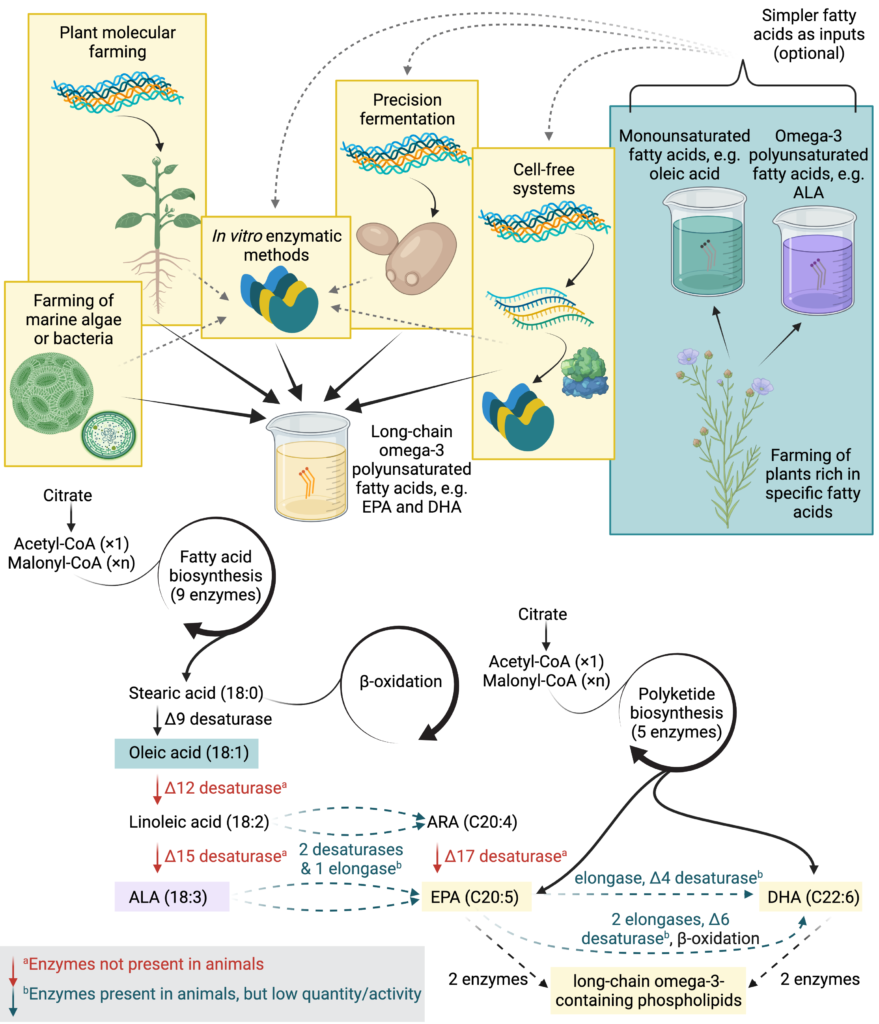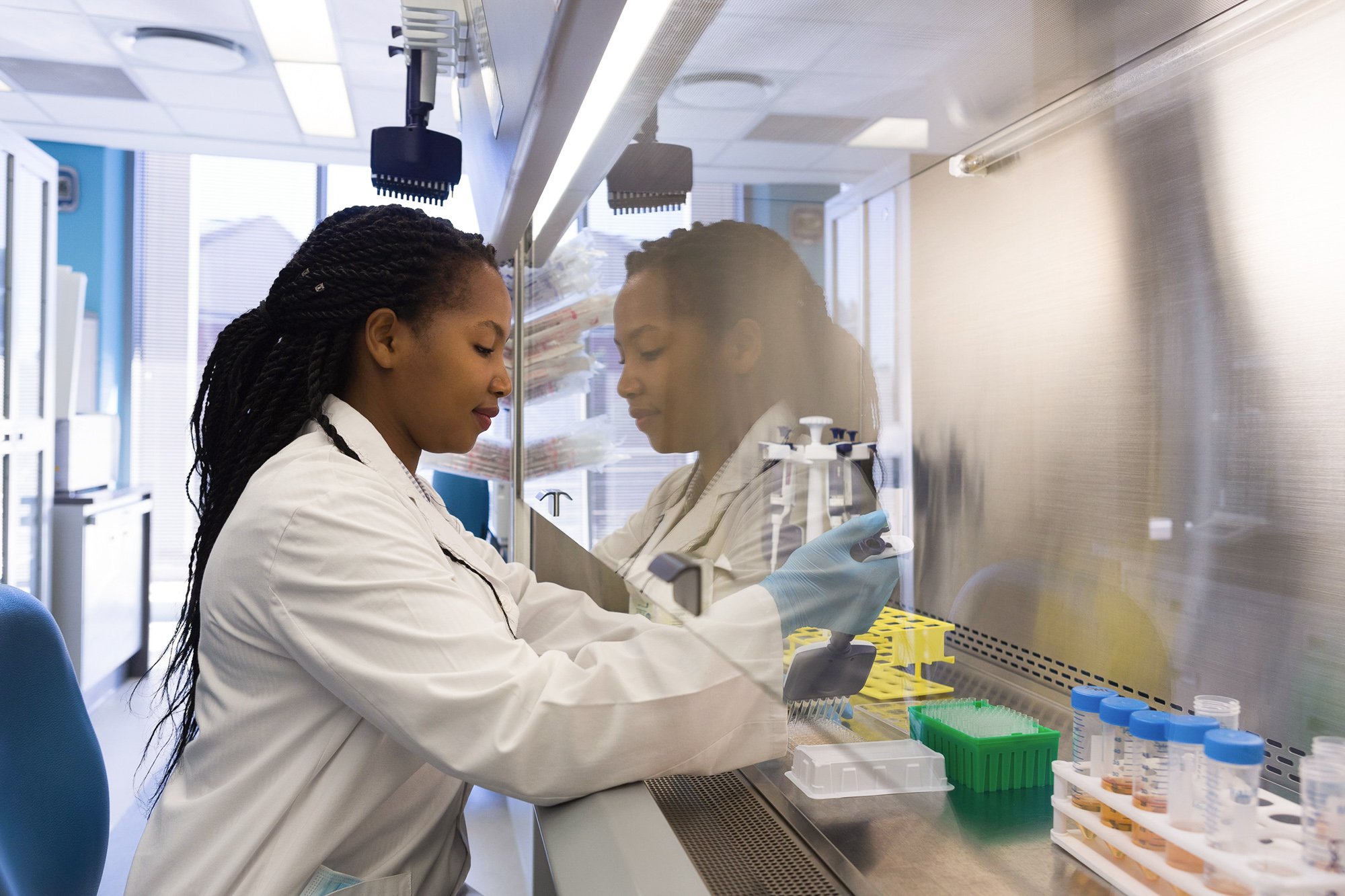Novel methods for long-chain omega-3 fatty acid production
As the alternative seafood industry scales up, a low-cost and abundant source of long-chain omega-3 polyunsaturated fatty acids will become necessary. Several means of producing these compounds have been investigated and commercialized, but additional innovation is needed to build a robust and scalable supply chain. Methods that would benefit from additional research include precision fermentation and cell-free systems.
-
Fermentation
- Research
- R&D
- Raw Materials, Ingredients, & Inputs
- Bioprocess design
- Host strain development
- Ingredient optimization
- Target molecule selection
- Industry
- Academics
- Startups
Current challenge
The abundance of long-chain (LC) omega-3 polyunsaturated fatty acids (PUFAs) in many types of seafood is frequently claimed as one of the major health benefits of regularly consuming seafood. For alternative seafood to claim nutritional equivalence with conventional products, the industry will need to achieve similar fatty acid (FA) profiles. If alternative seafood products with FA profiles equivalent to their conventional counterparts are to be produced at scale, either an abundant supply of the appropriate FAs will be necessary, or alternative seafood producers will need to develop methods to produce these compounds in-house.
Because animals, including fish, cannot synthesize omega-3 PUFAs themselves and therefore must obtain them from their diets, this challenge applies equally to cultivated and plant-based products. Omega-3 PUFAs of particular interest include α-linolenic acid (ALA)—which is an essential FA in animals and is produced by many plant species—as well as the LC omega-3 PUFAs eicosapentaenoic acid (EPA) and docosahexaenoic acid (DHA), which animals can synthesize in small quantities from ALA. The only known abundant naturally-occurring sources of EPA and DHA are marine algae and bacteria.
Existing methods for LC omega-3 PUFA production include cultivation of marine microalgae or bacteria, plant molecular farming, and precision fermentation. To the best of our knowledge, current commercial efforts are focused on the former two. A fermentation-based EPA oil was also commercialized in the past but appears to have been discontinued. Cell-free systems are another promising approach that, to our knowledge, have not been explored for the production of LC omega-3 PUFAs. Similarly, reconstitution of certain FA biosynthetic pathways by purified enzymes has been reported. As efforts are underway to scale up existing methods, further research is needed to explore methods that can increase the global LC omega-3 PUFA supply further.
Proposed solution
Precision fermentation
Precision fermentation, in which microorganisms are utilized as a production host to synthesize one or more specific proteins, is one promising strategy for the large-scale production of LC omega-3 PUFAs by expression of the necessary biosynthetic enzymes. Relative to more conventional fermentation hosts, oleaginous microorganisms—especially oleaginous yeasts such as Yarrowia lipolytica—may present some advantages when the desired compounds are FAs or fats, such as the ability to accumulate large amounts of intracellular lipids. Indeed, Y. lipolytica has been successfully engineered to produce high levels of EPA (56.6% of total FAs and 15% of dry cell weight). The strain contained 30 copies of 9 different genes and also had the function of the PEX10 gene disrupted. This disruption increased long-chain omega-3 PUFA synthesis by disrupting the β-oxidation pathway. DuPont commercialized a further-optimized version of this process in the form of New Harvest™ EPA oil. Engineered E. coli have also been used for monounsaturated fat (MUFA) synthesis.
Numerous variations on the idea of producing LC omega-3 PUFAs via fermentation may be imagined. Different hosts will pose different advantages and disadvantages. They can be optimized for greater efficiency, and the variety of metabolic pathways through which these compounds can be produced (discussed further below) allows a great deal of room for optimization, both in the interest of cost and scale and in the interest of optimizing the FA profile of the final product.
In vitro enzymatic methods and cell-free systems
The E. coli FA synthase has been successfully reconstituted in vitro from purified protein components. In this study, eight enzymes and a carrier protein were required to produce saturated FAs (SFAs) with chain lengths of C14-C18 from acetyl-CoA and malonyl-CoA, and a tenth protein, TesA, was added to release the free FAs. A method for FA production from citrate using algal lysates has been patented. The lysate already contains the necessary biosynthetic enzymes in this method because the chosen algal species express them. The lysates described in the patent produced primarily SFAs, though the FA profile was somewhat sensitive to culture conditions. Thus, this method could potentially be tuned to produce more of the desired LC omega-3 PUFAs. Another study measured FA synthesis in extracts from E. coli, to which specific purified enzymes were added.
Cell-free systems (CFS) containing the necessary machinery for transcription and translation can be produced either from cell extracts or by mixing purified components. The CFS can essentially be “programmed” to produce specific peptide or protein products by adding one or more DNA sequences. CFS have been successfully scaled to over 100L and have been used to reconstitute biosynthetic pathways for small molecules. To our knowledge, there have been no reports of a true CFS — according to the definition of the term as a “programmable liquid” — developed for FA synthesis. Such a system would have the advantage of allowing for precisely tunable ratios of different FAs simply by varying the ratios between the DNA constructs added, and in addition, could offer advantages in cost and scalability relative to systems requiring the purification and mixing of multiple biosynthetic enzymes.
Free fatty acids, phospholipids, and triglycerides
It will also be essential to consider the form in which FAs exist in the final product. Free FA content was positively correlated with the oxidation rate in vegetable oil and red palm oil. In both animals and plants, most FAs do not exist in their free form but are stored primarily as triglycerides, which are essentially three FAs linked by one molecule of glycerol. Substantial proportions of the LC omega-3 PUFAs from many marine sources exist as triglycerides and phospholipids. Some studies have indicated that the health benefits of the latter might be greater. Phospholipids are similar in structure to triglycerides, with one FA chain replaced by a phosphate-linked headgroup. Whereas FAs produced naturally by marine algae or bacteria or those produced using methods such as plant molecular farming and precision fermentation would be expected to exist mainly as triglycerides or phospholipids and not as free FAs, the same is not true of cell-free systems. Therefore, it will likely be desirable when using cell-free systems to introduce the necessary enzymes to convert the newly-created free LC omega-3 PUFAs into LC omega-3 PUFA-containing triglycerides or phospholipids. Such a strategy has been recently reported in a system where the FA synthesis pathway was reconstructed using purified enzymes, and two enzymes for phospholipid synthesis were expressed directly in the cell-free system. For other systems, it may also be important to consider the form in which the FAs are stored in the final product, as it could affect the rate of uptake by cells if used in cultivated meat or seafood or the bioavailability and health effects when the final product is eaten. Introducing additional genes into the system could be a strategy to, for example, increase the ratio of LC omega-3 PUFAs stored as phospholipids relative to triglycerides.

Bottom: Simplified overview of relevant biosynthetic pathways. Broken arrows indicate multiple steps for which intermediates are not shown. Multiple arrows for a single step indicate that there are multiple possible known pathways.
Created with Biorender.com
Choice of enzymes
Synthesis of LC omega-3 PUFAs can be broadly divided into three sets of steps based on what categories of organisms carry out each set of steps:
Synthesis of SFAs and MUFAs
Both SFAs and MUFAs are produced by a wide variety of organisms, for the most part using broadly similar mechanisms.
In E. coli, FA synthesis is carried out by ten proteins in total, consisting of eight biosynthetic enzymes, ACP (a carrier protein), and TesA (which releases the FA chain from ACP). FA synthesis occurs through a cyclical process initiated by single molecules of acetyl-CoA and malonyl-CoA, with an additional molecule of malonyl-CoA consumed in each cycle. This process produces SFAs of a variety of lengths. This process is largely conserved in yeast and mammals, though in these organisms, the enzymes and other proteins involved are fused into either one or two multi-domain proteins, which in yeast are referred to as FAS1 and FAS2.
MUFAs are produced by desaturation of SFAs, for example the desaturation of stearic acid to oleic acid by ∆9 desaturase.
Desaturation to omega-6 and omega-3 PUFAs
The desaturation of oleic acid into linoleic acid (LA, an omega-6 PUFA), and then of LA into ALA, does not occur in animals, meaning that LA and ALA are considered essential FAs. However, both land plants and many microorganisms are capable of synthesizing substantial amounts of LA and ALA. These sequential desaturation steps are carried out by the ∆12 and ∆15 desaturases.
Elongation and desaturation to LC omega-3 PUFAs
Conversion of LA or ALA into EPA and then of EPA into DHA occurs efficiently in marine algae and bacteria, consequently producing large quantities of these FAs. Although animal cells can carry out these steps, they generally do so in relatively small quantities. Plants are generally thought to convert LA and ALA into EPA in trace amounts, if at all.
EPA synthesis in animals can occur through several pathways: the ∆6 pathway, consisting of ∆6 desaturase, C18/20 elongase, and ∆5 desaturase; and the ∆9 pathway, consisting of ∆9 elongase, ∆8 desaturase, and ∆5 desaturase. Either one of these pathways converts LA into ARA, or ALA into EPA. The ∆17 desaturase can then convert ARA to EPA, bypassing the need for the ∆15 desaturase.
Synthesis of DHA from EPA has been shown to occur through at least two different pathways: first, through a pathway consisting of ∆5 elongase and ∆4 desaturase (in certain fungi), second, through a series of two elongation steps followed by ∆6 desaturation and then β-oxidation (in mammals).
Designing a complete pathway
In total, de novo synthesis of LC omega-3 PUFAs can be estimated to require 9-19 enzymes and other proteins, depending on the chosen pathway: 1-2 complex or ten simple proteins for the synthesis of SFAs, one for conversion to the MUFA oleic acid, two for conversion to ALA, three for conversion to EPA, and 2-3 for conversion to DHA. Because the multi-domain enzymes which carry out FA synthesis in eukaryotes may be more challenging to express, the actual number may be at the upper end of this range. Two additional enzymes would be needed to convert free FAs into phospholipids.
The number of proteins required could be higher if multiple copies are required or lower if a host system is used which already contains a sufficiently active FA synthase system (as well as possibly some of the required elongases and desaturases), as in the Y. lipolytica example discussed above, or by supplying the system with ALA (found in sources including chia and flax seeds) or with cheap and widely-available MUFAs such as oleic acid (the most abundant naturally-occurring FA, found in sources including canola and sunflower oil). The choice of biosynthetic pathway will be a key element in designing a highly productive and efficient cell-free or fermentation-based system for LC omega-3 PUFA synthesis. Complex CFS capable of turning simple precursors into LC omega-3 PUFAs are at least theoretically possible. CFS consisting of as many as 17 enzymes have been reported, as have systems of up to 27 purified enzymes.
In bacteria and algae, and most prominently in deep-sea marine bacteria, both EPA and DHA can also be synthesized directly from acetyl-CoA via the polyketide synthesis pathway without the involvement of FA synthase, elongase, or desaturase. The synthesis of PUFAs via the polyketide synthesis pathway is thought to involve the action of five genes, named pfaA-E, which show substantial homology with genes involved in the classical fatty acid synthesis pathway. To our knowledge, this pathway has thus far not been utilized in strategies for LC omega-3 PUFA production from heterologous systems or CFS. Given the observation that deep-sea marine bacteria, some of the most prolific producers of LC omega-3 PUFAs, are also known to utilize this pathway more than other organisms, it may be worth investigating whether the pathway might be successfully harnessed for scalable LC omega-3 PUFA production.
Comparing costs of methods, pathways, and feeding strategies
It is difficult to predict with any level of certainty how novel methods of producing LC omega-3 FAs might compare to existing methods once optimized and scaled up. Therefore, it will be helpful to develop techno-economic models once sufficient preliminary data exists so that efforts can be concentrated on the most promising methods. Models should also consider the choice of biosynthetic pathway and the strategy of feeding these systems with MUFAs or other low-cost FAs.
Anticipated impact
By expanding the number of commercially viable methods for the production of LC omega-3 FAs, it will be possible to build a more robust supply chain that is not dependent on the success of a single technology. Furthermore, some of these novel methods may offer advantages in terms of cost and scale, which will allow for an eventual reduction in the prices of alternative seafood products. Sufficiently cheap and abundant sources of LC omega-3 PUFAs may make it feasible for companies to produce “omega-3-enhanced” alternative meat and seafood products with omega-3 levels exceeding those found in their conventional counterparts for health-conscious individuals.
Because neither of the approaches discussed here includes genetically modified cells or tissues in the final product, gaining regulatory approval may be relatively straightforward. CFS are likely to be considered non-GMO, whereas the classification for precision fermentation-derived products depends on the jurisdiction.
CFS, in particular, may present several key advantages relevant to the production of fats for alternative proteins:
- The ratio of different FAs in the final product could be easily controlled by adding more or less of the DNA sequence encoding a particular enzyme, as opposed to cell-based systems in which expression levels may be more difficult to control precisely.
- The process may be cheaper and more efficient because inputs are used to create the desired final product, with no need to fuel cellular metabolism.
- Because there is no host system, it may be possible to produce higher concentrations of products without the risk of interfering with host cell viability (though FAs may still negatively impact enzyme stability and reaction rates, as has been reported).
Related efforts
Production of fatty acid-derived valuable chemicals in synthetic microbes (Yu et al. 2014, review)
New Harvest EPA oil, which was at one point produced by DuPont but appears to no longer be on the market, was based on two publications:
- Production of omega-3 eicosapentaenoic acid by metabolic engineering of Yarrowia lipolytica (Xue et al. 2013)
- Sustainable source of omega-3 eicosapentaenoic acid from metabolically engineered Yarrowia lipolytica: from fundamental research to commercial production (Xie et al. 2015)
Production of free monounsaturated fatty acids by metabolically engineered Escherichia coli (Cao et al. 2014)
In vitro enzymatic methods and cell-free systems
Synthetic biology goes cell-free (Tinafar et al. 2019, review)
In vitro reconstitution and steady-state analysis of the fatty acid synthase from Escherichia coli (Yu et al. 2011)
Fatty acid production in cell-free systems (Ho et al. 2014, patent)
Quantitative analysis and engineering of fatty acid biosynthesis in E. coli (Liu et al. 2010)
Reconstruction of phospholipid synthesis by combing in vitro fatty acid synthesis and cell-free gene expression (Eto et al. 2021, preprint)
Enzymatic conversion of plant-derived ALA to DHA/EPA (Castejon and Senorans 2019)
Applications of Microbial Enzymes in Food Industry (Raveendran et al. 2018, review)
Lignocellulolytic Enzymes in Biotechnological and Industrial Processes: A Review (Chukwuma et al. 2020, review)
Application of microbial α-amylase in industry – A review (Souza & Magalhães 2010, review)
Other Resources:
GFI resources

Research funding database
GFI’s research funding database provides curated grant opportunities for open-access alternative protein research.

Find collaborators
Join the GFIdeas global community of 2,000+ entrepreneurs, scientists, investors, and subject matter experts. Discuss projects on the members-only Slack community, attend monthly seminars, and use the community directory to help you find collaborators working on similar Solutions!
Related solutions
-
Fermentation
-
Plant-Based
Affordable animal-free omega-3 ingredients for alternative seafood and other alternative protein applications
In order to appeal to health-conscious consumers, alternative seafood products should contain similar omega-3 fatty acids, especially DHA and EPA, content to conventional seafood. Animal-free omega-3 ingredients can be expensive…
-
Cultivated
-
Fermentation
-
Plant-Based
Preventing oxidation of omega-3 fatty acids before and after addition to alternative seafood products
Deeper fundamental knowledge of the causes and prevention of oxidation of omega-3 fatty acids before, during, and after addition to alternative seafood products is needed to improve their nutritional and…
-
Cultivated
Understanding uptake and interconversion of omega-3 fatty acids by cultivated fish cells
Although fish are one of the best dietary sources of long-chain omega-3 fatty acids (FAs), these compounds are mostly bioaccumulated from a fish’s diet rather than synthesized de novo. Consistent…

Explore the full solutions database
Browse 100+ startup ideas, commercial opportunities, research projects, and investment priorities throughout the alternative protein supply chain.
Get involved
If you’d like to fund a research project, work on any of these solutions, share information about related efforts that are already underway, or elevate new ideas for advancing the alternative protein industry, we’d love to hear from you!
